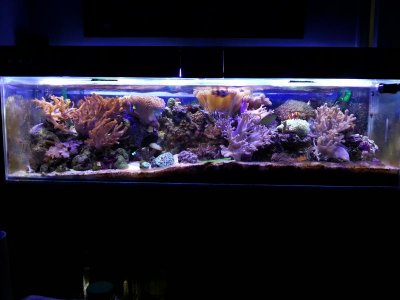Are you assuming a lens in in play here? I've lit 3 up over a six foot tank (not those chips, but other 100w multichips) and was happy with both depth penetration and shadow spread. I can't provide a photo ATM as I tore down the test setup and am prototyping over my biocue while I renovate the big tank, but it seemed to fit the need for me, curious what you saw that you don't like? (More worried I"ll not like it either!)
Yes a lot of this is personal taste. I personaly like to get more of an even light distribution rather than sharp shadows. True you will have some shaded areas to the eye, unless you put the lights in front of your tank, but I like to minimalize the shadows as much as possible.
If you look at some of the pictures you will see a very bright top of a coral while the underside is almost black as well as everything under it. This is something I do not like appearance wise. Through experementing and doing some trig calculations I have found that more point light sources hitting an area the less this shadow area is sharply defined.
Now do not get me wrong the multichip is a good idea provided it is applied correctly. As an example Johnny might want to put a single 150 watt on his 24" X 24" X 30" tall tank. But I think the lighting effect would be much better with say 4 37.5 watt multi chips. If they are dimmable then even 4-50 watt multi chips.
As far as lenses go there are places for them and there are places where they are over used. If the light angle on lenses is to small especialy on taller tanks where you have only one or two light sources hitting a specific spot then it will increase the shadows. But if they are wide enough that you still have multi point light sources hitting the same spot then they are advantages in all respects. Lenes realy show there value when you getting into taller tanks or putting the lights high above the surface. To me if you have 24" or more between the light source and the substrate then lenses should be strongly considered.
As an example I did a moonlight set up with 8-3 Watt Royal Blues running 90 degree lenses. I positioned the strip at the front of the tank on a 45 degree angle pointing to the botom rear. I ended up running them at 120 ma to give the proper moolight illumination or less than 1/2 watt each. I could see obvious hot spots where the center of each focused. And throughout the tank I got a fantastic shimmer effect. But I hated those hot spots. With the 90 degree lenses and the LEDs I was getting at least 4 LEDs hitting any given spot. I switched to 120 degree lenses and it helped the situation considerably but I still saw more shadowing than I was comfortable with. Eventualy I went with no lenses. The drawback of no lenses was that I had to up my power to 200 ma to get the same intensity and I did have light splilling on the floor in front of the tank. But the shimmer effect was still there which is what I was aiming for in the moon light effect.
Keep in mind that diferent people have different tastes when it comes to lighting. Some like extrem constrast emphisizing the color of a coral against a darker background. Others like a more evenly distributed light, and there are probably 100 levels between the two. It is like some people like a ratio of 1 to 1 neutral whites to Blues, while other like a 1 to 4 ratio. Think of the many diferent steps between there.
Yes you can get good lighting with 100 watt multichips on a 6 foot long tank. But how many are you using and how tall is the tank? Also if each color is seperatly dimmable how many watts of that light are you actualy using in the end? I here often people running 4 channels with only one channel at 100% and some channels even under 50%.

